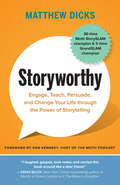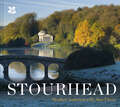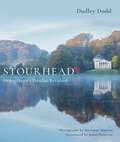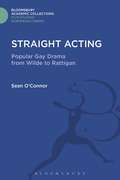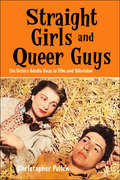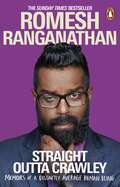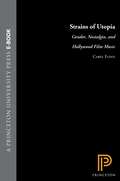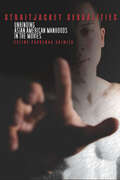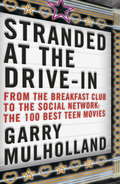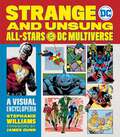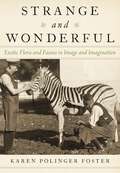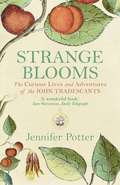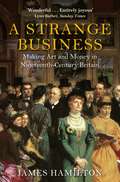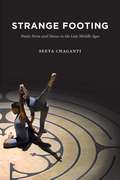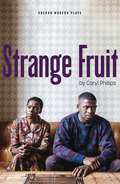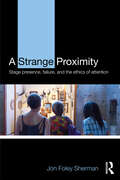- Table View
- List View
Storyworthy: Engage, Teach, Persuade, And Change Your Life Through The Power Of Storytelling
by Matthew Dicks Dan Kennedy"A 30-time StorySLAM champion shows readers how to improve their storytelling skills, and how doing so can improve their relationships, careers, and overall well-being"--.
Stourhead
by Stephen AndertonA beautifully illustrated celebration of Stourhead, featuring the legendary Georgian landscape garden in glorious autumn colour with essays by head gardener Alan Power.
Stourhead: Henry Hoare's Paradise Revisited
by Dudley Dodd'Brings both house and garden vividly to life... A magnificent achievement' Gardens Illustrated'A finely crafted work... it is an important record of the history of one of the country's most splendid estates' The English GardenThe Palladian house of Stourhead, in Wiltshire, occupies a plateau above the confluence of three valleys. When you cross the south lawn and descend the tree-hung slopes, you glimpse a lake adorned with classical temples. Continue and you will find an allegorical grotto; a gothick hideaway; a Pantheon of demi-gods and, on high, a deserted temple to Apollo. To the west Alfred's Tower commands views over three counties, a gaunt landmark to English monarchy and patriotism.This is how in Georgian times Henry Hoare – known as Henry the Magnificent – would have explored the garden he designed. Generations of the Hoare family, bankers who combined service with enlightened patronage and philanthropy, have developed and cultivated the garden at Stourhead, and for many its breathtaking vistas are paradise.Dudley Dodd charts the owners of Stourhead and the history of the landscape, house and art collection. He describes how flights of folly, individual flair, taste and careful stewardship have nurtured a national treasure, which is among the finest English landscape gardens and, since 1946, a jewel of The National Trust. The stunning new pictures by the renowned photographer Marianne Majerus provide an up to date record of this enduring Elysium.
Straight Acting: Popular Gay Drama from Wilde to Rattigan (Film Studies: Bloomsbury Academic Collections)
by Sean O'ConnorBetween the trials of Oscar Wilde in the 1890s and the beginnings of legal reforms in the 1960s, the West End stage was dominated by the work of gay playwrights. Many of their plays, such as Private Lives, Blithe Spirit and The Deep Blue Sea are established classics and continue to inform our culture. In this fascinating book, covering both familiar and lesser-known works, Sean O'Connor examines the legacy of Wilde as a playwright and as a gay man, and explores in the works of Somerset Maugham, Noel Coward and Terence Rattigan the resonance of Wilde's agenda for tolerance and his creed of individuality. O'Connor contextualises these plays against the enormous social and historical changes of the twentieth century. He also examines the legal restrictions which regulated the personal lives of these writers and required them to evolve sophisticated strategies in order to express on stage, albeit obliquely, their dilemmas as gay men. From the delicate homoerotic frissons of Rattigan's early comedies to Coward's defiantly pro-sex stance, Straight Acting is a provocative and witty insight into the subtly subversive tactics of gay writers working in that apparently most conservative of forms, the 'well-made play'.
Straight Girls and Queer Guys: The Hetero Media Gaze in Film and Television
by Christopher PullenExploring the archetypal representation of the straight girl with the queer guy in film and television culture from 1948 to the present day, Straight Girls and Queer Guys considers the process of the ‘hetero media gaze’ and the way it contextualizes sexual diversity and gender identity. Offering both an historical foundation and a rigorous conceptual framework, Christopher Pullen draws on a range of case studies, including the films of Doris Day and Rock Hudson, the performances of Kenneth Williams, televisions shows such as Glee, Sex and the City and Will and Grace, the work of Derek Jarman, and the role of the gay best friend in Hollywood film. Critiquing the representation of the straight girl and the queer guy for its relation to both power and otherness, this is a provocative study that frames a theoretical model which can be applied across diverse media forms.
Straight Outta Crawley: Memoirs of a Distinctly Average Human Being
by Romesh RanganathanStraight Outta Crawley is the hilarious and irreverent autobiography from comedian Romesh Ranganathan.At the age of 9, Romesh Ranganathan delivered his first ever stand-up set at a Pontin's holiday camp talent competition, smashing the other competitor, a young girl playing the kazoo.The gig went so well that Romesh retired his comic genius for twenty-two years, hiding behind the guise of a maths teacher, before finally revealing himself again (no, not like that) at the tender age of 31. In 2010, Ranganathan staged his epic comeback gig to an almost silent room, and has since gone on to earn his place as the most in-demand overweight vegan Sri Lankan comedian in Britain.Now, for the first time, he tells the full story of how he got here. From the delights of Sri Lankan hospitality to his struggles as a child, teacher and now parent, to his adolescent flirtation with a rap career and his attempts to make it in comedy, Straight Outta Crawley is Ranganathan's hilarious and irreverent autobiography.
Strains of Utopia: Gender, Nostalgia, and Hollywood Film Music
by Caryl FlinnWhen Dmitri Tiomkin thanked Johannes Brahms, Johann Strauss, Richard Strauss, and Richard Wagner upon accepting the Academy Award for his score of The High and the Mighty in 1954, he was honoring a romantic style that had characterized Hollywood's golden age of film composition from the mid-1930s to the 1950s. Exploring elements of romanticism in film scores of composers ranging from Erich Korngold to Bernard Herrmann, Caryl Flinn argues that films tended to link music to the sense of an idealized, lost past. Just as the score of Gone with the Wind captured the grandeur of the antebellum South, others prompted flashbacks or suggested moments of emotional intensity and sensuality. Maintaining that many films treated this utopian impulse as a female trait, Flinn investigates the ways Hollywood genre films--particularly film noir and melodrama--sustained the connection between music and nostalgia, utopia, and femininity. The author situates Hollywood film scores within a romantic aesthetic ideology, noting compositional and theoretical affinities between the film composers and Wagner, with emphasis on authorship, creativity, and femininity. Pointing to the lasting impact of romanticism on film music, Flinn draws from poststructuralist, Marxist, feminist, and psychoanalytic criticism to offer fresh insights into the broad theme of music as an excessive utopian condition.
Strains of Utopia: Gender, Nostalgia, and Hollywood Film Music
by Caryl FlinnWhen Dmitri Tiomkin thanked Johannes Brahms, Johann Strauss, Richard Strauss, and Richard Wagner upon accepting the Academy Award for his score of The High and the Mighty in 1954, he was honoring a romantic style that had characterized Hollywood's golden age of film composition from the mid-1930s to the 1950s. Exploring elements of romanticism in film scores of composers ranging from Erich Korngold to Bernard Herrmann, Caryl Flinn argues that films tended to link music to the sense of an idealized, lost past. Just as the score of Gone with the Wind captured the grandeur of the antebellum South, others prompted flashbacks or suggested moments of emotional intensity and sensuality. Maintaining that many films treated this utopian impulse as a female trait, Flinn investigates the ways Hollywood genre films--particularly film noir and melodrama--sustained the connection between music and nostalgia, utopia, and femininity. The author situates Hollywood film scores within a romantic aesthetic ideology, noting compositional and theoretical affinities between the film composers and Wagner, with emphasis on authorship, creativity, and femininity. Pointing to the lasting impact of romanticism on film music, Flinn draws from poststructuralist, Marxist, feminist, and psychoanalytic criticism to offer fresh insights into the broad theme of music as an excessive utopian condition.
Straitjacket Sexualities: Unbinding Asian American Manhoods in the Movies (Asian America)
by Celine ShimizuDepictions of Asian American men as effeminate or asexual pervade popular movies. Hollywood has made clear that Asian American men lack the qualities inherent to the heroic heterosexual male. This restricting, circumscribed vision of masculinity—a straitjacketing, according to author Celine Parreñas Shimizu—aggravates Asian American male sexual problems both on and off screen. Straitjacket Sexualities: Unbinding Asian American Manhoods in the Movies looks to cinematic history to reveal the dynamic ways Asian American men, from Bruce Lee to Long Duk Dong, create and claim a variety of masculinities. Representations of love, romance, desire, and lovemaking show how Asian American men fashion manhoods that negotiate the dynamics of self and other, expanding our ideas of sexuality. The unique ways in which Asian American men express intimacy is powerfully represented onscreen, offering distinct portraits of individuals struggling with group identities. Rejecting "macho" men, these movies stake Asian American manhood on the notion of caring for, rather than dominating, others. Straitjacket Sexualities identifies a number of moments in the movies wherein masculinity is figured anew. By looking at intimate relations on screen, power as sexual prowess and brute masculinity is redefined, giving primacy to the diverse ways Asian American men experience complex, ambiguous, and ambivalent genders and sexualities.
Stranded at the Drive-In: The 100 Best Teen Movies
by Garry MulhollandAcclaimed writer of This is Uncool and Popcorn turns his attention to the (first ever) look at the teen movieEveryone undergoes some kind of teenage trauma, and a fundamental way of coping, or rite of passage, is the teen movie. Yet until now there has been no book that explores this successful movie sub-genre with any depth.Step forward Garry Mulholland, who, taking his cue from his previous, hugely acclaimed pop culture list books (This is Uncool and Fear of Music), seeks to create a pantheon of the very finest teen movies, or in Garry Mulholland's words: 'I'll be doing what film critics have been loathe to do since the 1950s, and taking the entire subculture of teen movies seriously, making a constant and compelling argument that Grease and A Nightmare on Elm Street tell us a great deal more about modern life and human nature than Citizen Kane and The Godfather.'From Kes to Fame, Badlands to the Breakfast Club, and National Lampoon's Animal House to Twilight, Garry Mulholland re-evaluates a much maligned genre, and brings it all back again: the good, the bad and the traumatic.
Strange and Unsung All-Stars of the DC Multiverse: A Visual Encyclopedia
by Stephanie WilliamsMove over Batman, Superman, and Wonder Woman—Peacemaker is now on the scene and he&’s bringing along more than 100 of the most colorful characters from all corners of the DC multiverse in this officially licensed book. Peacemaker had a long road to the spotlight and he&’s not alone. There are dozens of unique, sometimes absurd, and yet truly memorable characters waiting for their chance to shine. Strange and Unsung All-Stars of the DC Multiverse celebrates some of the quirkiest, most compelling, and ready-for-primetime characters from throughout DC&’s history. With peculiar powers—from Matter-Eater Lad to Arm-Fall-Off Boy—and one-of-a-kind costumes—from Red Tornado with her red long johns and a cooking pot for a helmet to Blue Snowman with her wintry robotic armor—these characters are truly unforgettable. Dive in and discover your next favorite DC Super Hero or Villain.
Strange and Wonderful: Exotic Flora and Fauna in Image and Imagination
by Karen Polinger FosterEver since the creation of the world's first botanical and zoological gardens five thousand years ago, people have collected, displayed, and depicted plants and animals from lands beyond their everyday experience. Some did so to demonstrate power over distant territories, others to enhance prestige by possessing something no one had seen before. Exotica also satisfied intellectual curiosity, furthered scientific research, and educated and entertained. In addition, exotica, especially their state-sponsored representation, were often instruments of political persuasion, and in turn exerted considerable influence over expansionist policies. More than an account of gardens and menageries from antiquity to the present, Strange and Wonderful explores the imagery of exotic flora and fauna in Western art, seeking answers to certain fundamental and universal questions. How do artists, schooled in traditional modes of rendering the familiar, deal with the new and strange? Why are rare species deliberately introduced into images otherwise devoid of the unusual? What is the pictorialized relationship between exotic reality and artistic imagination? Karen Polinger Foster takes readers on a journey across millennia and around the globe, telling fascinating stories and meeting along the way such characters as Hatshepsut's baboons, Charlemagne's elephant, Dürer's rhinoceros, and Victoria's hippopotamus. What emerges is a sense of just how strong and far-reaching the pull of the unknown and exotic has been across time and space. Ultimately, images of the wonderful reveal as much about the indigenous as they do about the strange, enabling us to glimpse more vividly the power of imagination to mold the unknown to its purposes. This dazzling and richly illustrated volume offers a thoughtful, much-needed inquiry into a very human phenomenon.
Strange and Wonderful: Exotic Flora and Fauna in Image and Imagination
by Karen Polinger FosterEver since the creation of the world's first botanical and zoological gardens five thousand years ago, people have collected, displayed, and depicted plants and animals from lands beyond their everyday experience. Some did so to demonstrate power over distant territories, others to enhance prestige by possessing something no one had seen before. Exotica also satisfied intellectual curiosity, furthered scientific research, and educated and entertained. In addition, exotica, especially their state-sponsored representation, were often instruments of political persuasion, and in turn exerted considerable influence over expansionist policies. More than an account of gardens and menageries from antiquity to the present, Strange and Wonderful explores the imagery of exotic flora and fauna in Western art, seeking answers to certain fundamental and universal questions. How do artists, schooled in traditional modes of rendering the familiar, deal with the new and strange? Why are rare species deliberately introduced into images otherwise devoid of the unusual? What is the pictorialized relationship between exotic reality and artistic imagination? Karen Polinger Foster takes readers on a journey across millennia and around the globe, telling fascinating stories and meeting along the way such characters as Hatshepsut's baboons, Charlemagne's elephant, Dürer's rhinoceros, and Victoria's hippopotamus. What emerges is a sense of just how strong and far-reaching the pull of the unknown and exotic has been across time and space. Ultimately, images of the wonderful reveal as much about the indigenous as they do about the strange, enabling us to glimpse more vividly the power of imagination to mold the unknown to its purposes. This dazzling and richly illustrated volume offers a thoughtful, much-needed inquiry into a very human phenomenon.
Strange Blooms: The Curious Lives and Adventures of the John Tradescants
by Jennifer PotterIn seventeenth-century Britain, a new breed of 'curious' gardeners were pushing at the frontiers of knowledge and new plants were stealing into Europe from East and West. John Tradescant and his son were at the vanguard of this change - as gardeners, as collectors and above all as exemplars of an age that began in wonder and ended with the dawning of science. Jennifer Potter's book vividly evokes the drama of their lives and takes its readers to the edge of an expanding universe. Strange Blooms is a magnificent pleasure for gardeners and non-gardeners alike.This 'wonderful book' (Jane Stevenson, Daily Telegraph) describes the remarkable lives and times of the John Tradescants.
Strange Bridges: Band 6 orange (PDF) (Collins Big Cat Phonics For Letters And Sounds Ser.)
by Isabel ThomasCollins Big Cat Phonics for Letters and Sounds features exciting fiction and non-fiction decodable readers to enthuse and inspire children. They are fully aligned to Letters and Sounds Phases 1-6 and contain notes in the back. The Handbooks provide support in demonstration and modelling, monitoring comprehension and expanding vocabulary. Find out all about the different unusual bridges around the world, from see-through bridges to ones that look like dragons, in this photographic non-fiction book by Isabel Thomas. Orange/Band 6 books offer varied text and characters, with action sustained over several pages. The focus sounds in this book are: /ai/ eigh /ee/ e-e, ey, e, y /oo/ u /igh/ y /c/ ch /j/ g, ge, dge /l/ le /f/ ph /w/ wh /v/ ve /s/ se /z/ se Pages 22 and 23 allow children to re-visit the content of the book, supporting comprehension skills, vocabulary development and recall. Reading notes within the book provide practical support for reading Big Cat Phonics for Letters and Sounds with children, including a list of all the sounds and words that the book will cover.
A Strange Business: Making Art and Money in Nineteenth-Century Britain
by James HamiltonShortlisted for the Apollo Awards 2014Longlisted for the Art Book Prize 2014 Britain in the nineteenth century saw a series of technological and social changes which continue to influence and direct us today. Its reactants were human genius, money and influence, its crucibles the streets and institutions, its catalyst time, its control the market.In this rich and fascinating book, James Hamilton investigates the vibrant exchange between culture and business in nineteenth-century Britain, which became a centre for world commerce following the industrial revolution. He explores how art was made and paid for, the turns of fashion, and the new demands of a growing middle-class, prominent among whom were the artists themselves. While leading figures such as Turner, Constable, Landseer, Coleridge, Wordsworth and Dickens are players here, so too are the patrons, financiers, collectors and industrialists; lawyers, publishers, entrepreneurs and journalists; artists' suppliers, engravers, dealers and curators; hostesses, shopkeepers and brothel keepers; quacks, charlatans and auctioneers. Hamilton brings them all vividly to life in this kaleidoscopic portrait of the business of culture in nineteenth-century Britain, and provides thrilling and original insights into the working lives of some of our most celebrated artists.
Strange Footing: Poetic Form and Dance in the Late Middle Ages
by Seeta ChagantiFor premodern audiences, poetic form did not exist solely as meter, stanzas, or rhyme scheme. Rather, the form of a poem emerged as an experience, one generated when an audience immersed in a culture of dance encountered a poetic text. Exploring the complex relationship between medieval dance and medieval poetry, Strange Footing argues that the intersection of texts and dance produced an experience of poetic form based in disorientation, asymmetry, and even misstep. Medieval dance guided audiences to approach poetry not in terms of the body’s regular marking of time and space, but rather in the irregular and surprising forces of virtual motion around, ahead of, and behind the dancing body. Reading medieval poems through artworks, paintings, and sculptures depicting dance, Seeta Chaganti illuminates texts that have long eluded our full understanding, inviting us to inhabit their strange footings askew of conventional space and time. Strange Footing deploys the motion of dance to change how we read medieval poetry, generating a new theory of poetic form for medieval studies and beyond.
Strange Footing: Poetic Form and Dance in the Late Middle Ages
by Seeta ChagantiFor premodern audiences, poetic form did not exist solely as meter, stanzas, or rhyme scheme. Rather, the form of a poem emerged as an experience, one generated when an audience immersed in a culture of dance encountered a poetic text. Exploring the complex relationship between medieval dance and medieval poetry, Strange Footing argues that the intersection of texts and dance produced an experience of poetic form based in disorientation, asymmetry, and even misstep. Medieval dance guided audiences to approach poetry not in terms of the body’s regular marking of time and space, but rather in the irregular and surprising forces of virtual motion around, ahead of, and behind the dancing body. Reading medieval poems through artworks, paintings, and sculptures depicting dance, Seeta Chaganti illuminates texts that have long eluded our full understanding, inviting us to inhabit their strange footings askew of conventional space and time. Strange Footing deploys the motion of dance to change how we read medieval poetry, generating a new theory of poetic form for medieval studies and beyond.
Strange Footing: Poetic Form and Dance in the Late Middle Ages
by Seeta ChagantiFor premodern audiences, poetic form did not exist solely as meter, stanzas, or rhyme scheme. Rather, the form of a poem emerged as an experience, one generated when an audience immersed in a culture of dance encountered a poetic text. Exploring the complex relationship between medieval dance and medieval poetry, Strange Footing argues that the intersection of texts and dance produced an experience of poetic form based in disorientation, asymmetry, and even misstep. Medieval dance guided audiences to approach poetry not in terms of the body’s regular marking of time and space, but rather in the irregular and surprising forces of virtual motion around, ahead of, and behind the dancing body. Reading medieval poems through artworks, paintings, and sculptures depicting dance, Seeta Chaganti illuminates texts that have long eluded our full understanding, inviting us to inhabit their strange footings askew of conventional space and time. Strange Footing deploys the motion of dance to change how we read medieval poetry, generating a new theory of poetic form for medieval studies and beyond.
Strange Footing: Poetic Form and Dance in the Late Middle Ages
by Seeta ChagantiFor premodern audiences, poetic form did not exist solely as meter, stanzas, or rhyme scheme. Rather, the form of a poem emerged as an experience, one generated when an audience immersed in a culture of dance encountered a poetic text. Exploring the complex relationship between medieval dance and medieval poetry, Strange Footing argues that the intersection of texts and dance produced an experience of poetic form based in disorientation, asymmetry, and even misstep. Medieval dance guided audiences to approach poetry not in terms of the body’s regular marking of time and space, but rather in the irregular and surprising forces of virtual motion around, ahead of, and behind the dancing body. Reading medieval poems through artworks, paintings, and sculptures depicting dance, Seeta Chaganti illuminates texts that have long eluded our full understanding, inviting us to inhabit their strange footings askew of conventional space and time. Strange Footing deploys the motion of dance to change how we read medieval poetry, generating a new theory of poetic form for medieval studies and beyond.
Strange Footing: Poetic Form and Dance in the Late Middle Ages
by Seeta ChagantiFor premodern audiences, poetic form did not exist solely as meter, stanzas, or rhyme scheme. Rather, the form of a poem emerged as an experience, one generated when an audience immersed in a culture of dance encountered a poetic text. Exploring the complex relationship between medieval dance and medieval poetry, Strange Footing argues that the intersection of texts and dance produced an experience of poetic form based in disorientation, asymmetry, and even misstep. Medieval dance guided audiences to approach poetry not in terms of the body’s regular marking of time and space, but rather in the irregular and surprising forces of virtual motion around, ahead of, and behind the dancing body. Reading medieval poems through artworks, paintings, and sculptures depicting dance, Seeta Chaganti illuminates texts that have long eluded our full understanding, inviting us to inhabit their strange footings askew of conventional space and time. Strange Footing deploys the motion of dance to change how we read medieval poetry, generating a new theory of poetic form for medieval studies and beyond.
Strange Footing: Poetic Form and Dance in the Late Middle Ages
by Seeta ChagantiFor premodern audiences, poetic form did not exist solely as meter, stanzas, or rhyme scheme. Rather, the form of a poem emerged as an experience, one generated when an audience immersed in a culture of dance encountered a poetic text. Exploring the complex relationship between medieval dance and medieval poetry, Strange Footing argues that the intersection of texts and dance produced an experience of poetic form based in disorientation, asymmetry, and even misstep. Medieval dance guided audiences to approach poetry not in terms of the body’s regular marking of time and space, but rather in the irregular and surprising forces of virtual motion around, ahead of, and behind the dancing body. Reading medieval poems through artworks, paintings, and sculptures depicting dance, Seeta Chaganti illuminates texts that have long eluded our full understanding, inviting us to inhabit their strange footings askew of conventional space and time. Strange Footing deploys the motion of dance to change how we read medieval poetry, generating a new theory of poetic form for medieval studies and beyond.
Strange Fruit (Oberon Modern Plays)
by Caryl Phillips"I go half way round the world and back thinking I’d made some sort of discovery and come back to find the same damn lies, the same white lies, the same black lies." Alvin and Errol can’t picture much of a future for themselves. They’re young, Black and living in England in the 1980s, with an entire country and political system set against them. Instead they focus firmly on their past – the sunny Caribbean and heroic father they left behind when their mother brought them to England twenty years ago. But when Alvin returns home from his grandfather’s funeral a new version of their past emerges, and the two brothers are caught in a desperate struggle to unearth the truth about their existence. Powerful and compelling, Strange Fruit by Caryl Phillips (winner of the Commonwealth Writers’ Prize) is the story of a family caught between two cultures, and the uncrossable no man’s land that can come between parents and their children.
A Strange Proximity: Stage Presence, Failure, and the Ethics of Attention
by Jon Foley ShermanWhat happens in the relationship between audience and performer? What choices are made in the space of performance about how we attend to others? A Strange Proximity examines stage presence as key to thinking about performance and ethics. It is the first phenomenological account of ethics generated from, rather than applied to, contemporary theatrical productions. The ethical possibilities of the stage, argues Jon Foley Sherman, rest not so much in its objects—the performers and the show itself—as in the “how” of attending to others. A Strange Proximity is a unique perspective on the implications of attention in performance.
A Strange Proximity: Stage Presence, Failure, and the Ethics of Attention
by Jon Foley ShermanWhat happens in the relationship between audience and performer? What choices are made in the space of performance about how we attend to others? A Strange Proximity examines stage presence as key to thinking about performance and ethics. It is the first phenomenological account of ethics generated from, rather than applied to, contemporary theatrical productions. The ethical possibilities of the stage, argues Jon Foley Sherman, rest not so much in its objects—the performers and the show itself—as in the “how” of attending to others. A Strange Proximity is a unique perspective on the implications of attention in performance.
